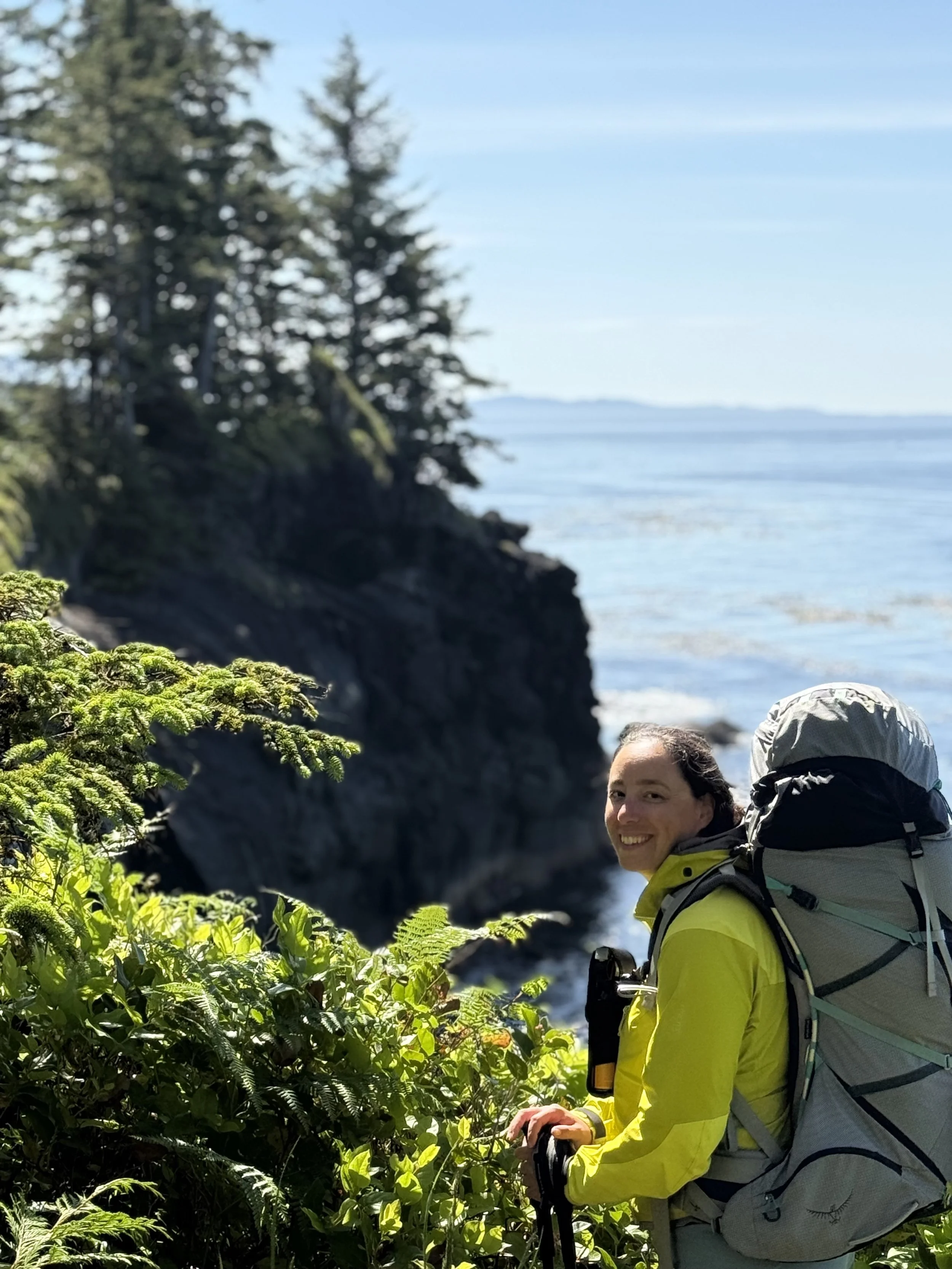
adventure blog
Seeing Beneath the Skin: The Promise of Mixed Reality + Imaging-Guided Acupuncture
In traditional acupuncture practice, locating and inserting needles at the “correct” acupoint (in location, orientation, depth) relies heavily on anatomical knowledge, palpation, and practitioner experience. Novices must learn via repetition, observation, and “feeling their way” over time. But what if technology could help “see beneath the skin” and provide real-time guidance? That is the central idea behind Mixed Reality + Imaging-Guided Acupuncture, sometimes specifically termed MRUCT (Mixed Reality Assistance for Acupuncture Guided by Ultrasonic Computed Tomography).
Acupuncturist Crystal hikes the Nootka Trail in 2025 (Part 2)
Sports Acupuncturist Crystal shares her itinerary on the Nootka Trail. Read on for more advice for tackling this incredible hike!
Acupuncturist Crystal hikes the Nootka Trail in 2025 (Part 1)
Sports Acupuncturist Crystal shares her adventures on the Nootka Trail. Read on for more advice for tackling this incredible hike!
Ride stronger, heal smarter: Why motorcycle riders are turning to physiotherapy at Elios Health
Motorcycle riders in Vancouver trust physiotherapist and ICBC-certified instructor Len Chong at Elios Health. Whether you're prepping for your motorcycle license or recovering from a crash, Len combines expert rehab with real riding experience. Book now for motorcycle-specific treatment covered by ICBC.
What do acupuncturists do? Sports acupuncture might be what you’ve been missing!
Discover what acupuncturists do and how sports acupuncture helps with pain, recovery, and performance. At Elios Health in Vancouver, Crystal Gilhooly uses acupuncture to treat active bodies—climbers, runners, and everyday athletes—by reducing pain, restoring function, and speeding up recovery with evidence-based care.
Athletic Recovery: Gua Sha Therapy in Climbing and Sports Rehab
Gua sha is a traditional technique used to reduce muscle tension, improve circulation, and speed up recovery. At Elios Health in Vancouver, we use gua sha to relieve pain, break up adhesions, and support injury rehab—especially for athletes and active individuals. It’s a powerful tool for restoring mobility and relieving chronic or acute tightness.
Unlock your rehab plan: Sports massage with Jeremy Ivey in Vancouver
Looking for sports massage near me on Main Street Vancouver? Jeremy Ivey, former Olympic rowing coach turned clinician, offers expert sports massage and physiotherapy tailored for climbers, runners, and athletes. Optimize performance and recovery with coaching-informed care. Book now on Main Street Vancouver.
Peak Performance on Main Street: How Sports Acupuncture Supports Climbers, Gymnasts, and Outdoor Athletes
Looking for acupuncture near me? Discover how acupuncture on Main Street supports athletic performance and recovery for climbers, gymnasts, and outdoor adventurers. Reduce pain, speed healing, and boost energy with expert care tailored to active lifestyles. Experience the benefits of sports acupuncture today.
“Ban the Clam?” Rethinking the clamshell exercise in post hip arthroplasty rehab
While the clamshell can be a useful exercise to strengthen the hip abductors, there are certain cases in which it may be contraindicated. One example of a scenario when the clamshell exercise may be counterproductive is in patients with lateral hip pain caused by gluteal tendinopathies.
5 Exercises for ‘Climber’s Elbow’
Medial epicondylitis, also known as climber’s, golfer’s, or baseball elbow; is an overuse injury of the elbow characterized by pain from the elbow to the rest on the medial side of the elbow. The medial elbow region is prone to overuse injuries in climbing for a couple of reasons.
Physiotherapy will be an extremely important aspect of medial epicondylitis treatment. As climber’s and athletes, the physiotherapists at Elios Health are very familiar with medial epicondylitis and want to help you minimize the impact your symptoms place on your climbing and daily activities.
6 Symptoms of ‘Skier’s Thumb’
It’s the time of year for winter sports and snow-packed adventures. “Skier’s Thumb” is one of the most common hand injuries associated with winter sports.
To ensure success as you hit the slopes, read this blog post to learn all about the anatomy, symptoms, causes, and treatment options for Skier’s Thumb.
If you sustain a thumb injury this winter and are in the Greater Vancouver area, consult with us at Elios Health so that you can return to your winter activities safely. With the proper treatment and rehabilitation, we can help get you back to the mountains pain-free as soon as possible.
Knee Pain While Squatting and 3 Tips to Prevent It!
The knee is designed to move through flexion and extensions and facilitate the squatting motion. For most people, it should not cause knee pain, however, knee pain while squatting is a very common complaint.
Usually, the issue stems from poor movement patterns when performing the exercise due to muscle imbalances, limited mobility, and poor form. When left unaddressed, these issues can lead to acute and chronic knee injuries.
3 Exercise to Improve Shoulder Stability
Rachel (Physio Beta) is at it again.
Enjoy three of her favourite exercises for improving shoulder stability.
Hint: one of them requires balance!
How to start running postpartum
Getting back into running postpartum can be a difficult task. Not only do new moms face complete changes to their daily routines but their muscles, joints and ligaments also go through drastic changes as well.
We would hardly expect injured athletes to be able to jump back into running at a pre-injury level and becoming a new mother is no different.
The following provides some information to consider when returning to running postpartum.
3 Phases of Rehab from Lateral Ankle Sprain
Oh no, a sprained ankle!
It’s one of the most frustrating times is when you just can’t “walk it off”.
Let’s take a look at what’s going on down there…
8 Signs of an ACL Injury
The ACL is the most commonly injured ligament in the knee and often affects younger, active individuals who participate in sports. Injuries to the ACL are usually caused by non-contact rotational forces such as sudden changes in direction, rapid stopping, jumping, and landing abnormally.
The Anterior cruciate ligament (ACL) is one of the key ligaments that act to stabilize the knee joint. The ACL connects your thighbone (femur) to the shin (tibia). Together with the posterior cruciate ligament (PCL), the ACL forms a cross-shaped band that prevents excessive forwards or backward movement of the shinbone relative to the thigh, as well as provides the knee with rotational stability.
6 Types of Manual Therapy that will Leave you Feeling Better
Manual therapy encompasses a range of techniques used by physiotherapists to assess and treat injuries and chronic conditions causing pain, stiffness, and reduced range of motion of the arms, legs, and spine. It involves hands-on treatments geared towards improving muscle function while minimizing pain.
Read on to learn more about the types of manual therapy, and who it helps!
What is a Rotator Cuff Tear?
What is a rotator cuff? What are people always talking about it? In fact, what makes it a “cuff”? Is it like a cuff link?
Ok, we are getting a little out of hand here.
Read on to learn more about the anatomy of the shoulder, and our three favourite exercises to prevent rotator cuff injuries!
Acute vs Chronic Injuries
How do you know if your pain is just something from last weekend's adventure or a sign of something more long-term? In this post we look at signs and symptoms of chronic and acute injuries, and what to do when you think it is something more than leftover stiffness.
IMS vs acupuncture: What is the difference?
Acupuncture and intramuscular stimulation (IMS) can both be effective modalities for pain management. The two treatments are similar in that they both involve the insertion of a thin, single-use, sterile needle to stimulate healing. The two treatments differ in the way that the needles are used and the conditions that they address.




















